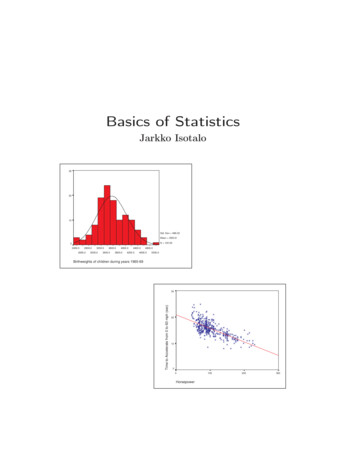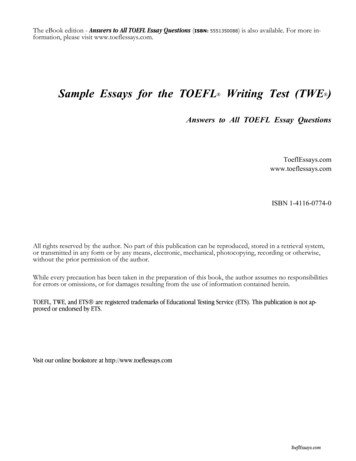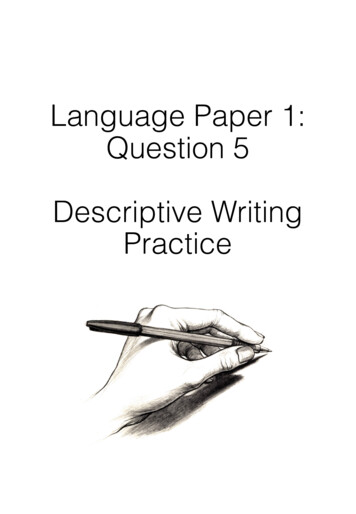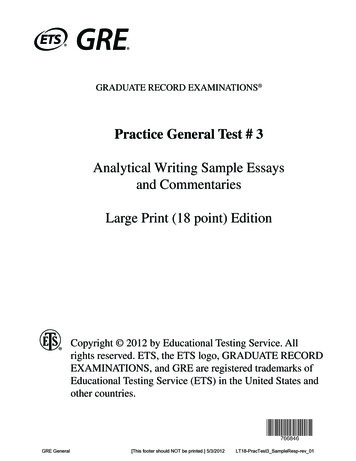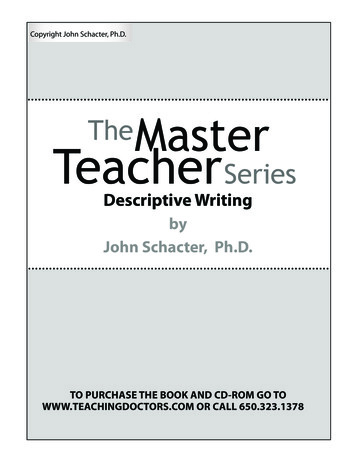
Transcription
Copyright John Schacter, Ph.D.TheMasterTeacher SeriesDescriptive WritingbyJohn Schacter, Ph.D.TO PURCHASE THE BOOK AND CD-ROM GO TOWWW.TEACHINGDOCTORS.COM OR CALL 650.323.1378
MasterTeacher SeriesTheDescriptive WritingContentsPrefaceLESSON 1: Pretest and PortfoliosLESSON 2: Introduction to Descriptive WritingLESSON 3: The Snow Person (Attribute Charts)LESSON 4: The Storm (Where Topic Sentences)LESSON 5: The Storm (Top to Bottom Paragraph Frames)LESSON 6: The Storm (Writing Concluding Sentences)LESSON 7: The Storm (Revising for Precise Language)LESSON 8: The Playground (When Topic Sentences)LESSON 9: The Playground (Left to Right Paragraph Frames)LESSON 10: The Playground (Writing Concluding Sentences)LESSON 11: The Playground (Revising for Strong Verbs)LESSON 12: The Insect (Skill Review & Attribute Charts)LESSON 13: The Insect (Writing Comparison Sentences)LESSON 14: The Insect (Details Paragraph Frame)LESSON 15: The Insect (Interesting Fact Topic Sentences)LESSON 16: The Insect (Writing Concluding Sentences)811151822263135404549556063677075
Contents ContinuedLESSON 17: The Insect (Skill Review)LESSON 18: The Place (Creating Attribute Charts)LESSON 19: The Place (Precise Words, Verbs & Comparisons Draft)LESSON 20: The Place (Evaluate & Rewrite)LESSON 21: Descriptive Writing PosttestLESSON 22: Pretest to Posttest Growth (Self-Evaluate)LESSON 23: Sentence CombiningLESSON 24: Writing Multi-Paragraph EssaysLESSON 25: The Stuffed Toy (Creating Attribute Charts)LESSON 26: The Stuffed Toy (Essay Organizer)LESSON 27: The Stuffed Toy (Writing Your First Draft)LESSON 28: Sentence CombiningLESSON 29: The Stuffed Toy (Writing Orientations)LESSON 30: The Stuffed Toy (Writing Closing Paragraphs)LESSON 31: The Stuffed Toy (Self-Evaluation & Feedback)LESSON 32: The Stuffed Toy (Evaluating Classmates’ Essays)REFERENCESTO PURCHASE THE BOOK AND CD-ROM GO TOWWW.TEACHINGDOCTORS.COM OR CALL 5141146
4PrefacePrefaceThis book and accompanying CD ROMincorporate the best in educational researchwith classroom practices that show thetheory in action. In this volume, we present32 lessons on how to teach descriptive writing in grades 1 to 5. Each lesson is guidedby experimentally proven writing strategiesthat increase student achievement from 13to 86 percent (see reviews by Hillocks,1984,and Graham & Perin, 2007). In the pagesthat follow, lessons are described throughvisual storyboards. All lessons includeTeacher PowerPoint Slides (with grade-levelspecific model texts, prompts, pictures, andactivities), and Student Workbooks stored onthe accompanying CD ROM.Writing this book and developing the teaching examples would not have been possiblewithout the creativity of classroom teachers,researchers, and state department educators. Thank you, Dr. Gina Koency, KatieWelch, Janet Grevious, Dr. Phyllis Veith, EllenOderman, Paula Wykle, and Kathy Mears foryour instructive comments and encouragement! Appreciation is also expressed toJennifer Duke for her graphic design, PaulKepple for his innovative cover artwork,and Joanne Michiuye for her meticulouscopyediting. Lastly, thank you Nikki Serafinfor your abundant creativity and wealth ofideas.Model Texts, Pictures and SkillDevelopment ActivitiesTeaching writing involves careful selectionof pictures, model texts, prompts, rubrics,and skill development activities. Considerable time and effort were spent creatingthe Teacher PowerPoint Slides and StudentWorkbooks that house these materials.While the descriptive writing skills taughtin this book remain the same each year,the model texts, activities, and performance demands change based on gradelevel expectations.Lesson ProgressionLessons progress from writing simpledescriptive sentences to paragraphs tomulti-paragraph essays. Skill developmentexercises range from generating descriptive attributes to sentence combining toincluding comparisons and hyperbole.Some first-and second-grade students maynot be ready to compose multi-paragraphdescriptions. Others may. We encourageteachers to use their judgment to decidehow far through this curriculum each student is prepared to advance. As educators,we know that students learn at differentrates and enter every grade with differentperformance levels. That being said, a possible ending point for lower elementarystudents (grades 1 to 3) is Lesson 21.TO PURCHASE THE BOOK AND CD-ROM GO TOWWW.TEACHINGDOCTORS.COM OR CALL 650.323.1378
5Defining Descriptive Writing and How to Use This BookWhat Is Descriptive Writing?Descriptive writing describes a person,place, or thing in a way that enables thereader to visualize it. This type of writing ischaracterized by: sensory details,precise language (tulip instead of flower;mansion instead of home),comparisons (under the jeweled sky;speaks like a queen),strong verbs (He slammed the bookdown.), andhyperbole (faster than a speeding bullet;strong as an ox).Why Write Descriptively?Writing descriptively teaches students to: organize their thinking,search for and communicate details,define people, places and things, andwrite with clarity and purpose.Teaching Descriptive WritingRather than teach writing using a singular approach (e.g. process writing, rubrics,study of models, collaborative writing,self-regulation strategies, scaffolds, etc.) weemploy a variety of experimentally provenstrategies (see Reference section).While your students will experience elements of process writing, study of models,rubrics, collaborative writing, and self-regulation strategies, the guiding instructionalapproach in this book is called Goals andProgress Feedback (Schunk & Swartz, 1993).In a recent review of experimental writing studies, Graham & Perin (2007) demonstrated that students taught the Goalsand Progress Feedback approach gained onaverage 26 percent more on a variety ofwriting assessments than similar studentsrandomly assigned to control groups.The Goals and Progress Feedback writing approach includes:1. INTRODUCING THE WRITING GOAL2. MODELING THE WRITING SKILL3. PRACTICING THE SKILL OUT OF CONTEXT4. USING THE SKILL IN CONTEXT5. RECEIVING IMMEDIATE FEEDBACK6. RETEACHING AND/OR EXTENDING SKILLUSEImproving Writing Requires ExpertInstruction and PracticeDon’t expect your students to master all thedescriptive writing skills introduced in thiseight-week curriculum. These skills needto be retaught and reinforced throughoutstudents’ elementary education.How to Use This BookThis book is a curriculum with 32 descriptive writing lessons. Accompanying thisbook are grade-level-specific TeacherPowerPoint Slides and Student Workbooks.While the writing skills and strategies arethe same each year, the prompts, pictures,model texts, examples, and writing exercises change for each grade level.The Descriptive Writing Skill Sheet on thenext page shows the writing skills you willteach. Each “X” represents how many timesthat skill is introduced.
6Descriptive Writing Skill SheetDescriptive Writing Skill SheetCOMPOSING SKILLSIncludes descriptive words and details (look, sound, movement,taste, composition, age, size, location, etc.).X X X X X XUses precise language (tulip instead of flower; mansion insteadof home).X X X XIncludes strong verbs (She raced to the park. He gulped downhis lunch.).X X X X XUses transitions (Before, During, After . . . In front of, Behind,Beside) and sentence variation (combines choppy sentences,revises repetitive sentence starts).X X X XMakes comparisons (fast as lightning, hair like silk, hotter thanburning coal).X X XUses words that engage and surprise the reader (enormousshrimp; muscles bigger than a mountain).*X XORGANIZING SKILLSGenerates attribute charts to develop and sort ideas and detailsfor descriptive writing.X X X X X XOrganizes descriptions either by time, visual field (left to right;top to bottom; small to large), details, or procedure.X X X X X XWrites topic sentences that orient and engage the reader.X X X X X X XWrites concluding sentences that use a concluding word orphrase, give advice, or summarize the description.X X X X X X X*This skill is taught in the 4th and 5th grade Teacher PP Slides.
Lesson 47Lesson 4: Descriptive Paragraph #1, The StormOUTCOMESStudents will: Write Where Topic Sentences. Create a descriptive attribute chart todescribe a picture of a storm.MATERIALS Teacher PP Slides Student whiteboards Red and Black dry erase markers Post It Notes Where Topic Sentence PosterPREPARATION Read the lesson storyboards.1Today, we have two writing goals. One is writing TopicSentences, the other is generating descriptive attributes.Open your workbooks and put a check next to: Writes topicsentences that orient and engage the reader. Put anothercheck next to: Generates attribute charts.DESCRIPTIVE WRITING SKILL SHEETORGANIZING SKILLSGenerates attribute charts to develop and sort ideas anddetails for descriptive writing.Organizes descriptions either by time, visual field (left toright; top to bottom; small to large; large to small), or procedure.Writes topic sentences that orient and engage the reader.Writes concluding sentences that use a concluding word orphrase, give advice, or summarize the description.2One way to engage and orient a reader is to tell the readerWHERE what you’re describing takes place. There are lotsof ways to write WHERE Topic Sentences. On our writingbulletin board, I have placed several examples. In a minute, you’ll practice writing different WHERE Topic Sentences.WRITING WHERETOPIC SENTENCES In the school gym . . . .Across the train tracks . . .Inside our classroom . . .At my friend’s pool . . .Next to the creek . . .On the soccer field . . .Outside my bedroom window . . .
8Lesson 434I’m going to write a WHERE Topic Sentence for this picture(volcano). When you write a WHERE Topic Sentence, firstlook at the Topic Sentence Poster for an idea. I’m going tostart with “On the soccer field . . . “ But this isn’t a picture ofa soccer field it’s “On the big island of Hawaii . . . “ I’ll writethis with my BLACK marker on my dry erase board.5CITY WHAT HAPPENEDAMUSEMENT PARKWHEREWHAT HAPPENEDSTORMWHEREWHEREOn the big island ofHawaiiWHAT HAPPENEDthe volcano eruptedWHERENext to my grandpa’ssugar cane fieldWHAT HAPPENEDI heard the volanorumble6Here’s another picture (CITY). On your whiteboards, makean organizer that looks like this. First write the WHERE partof your Topic Sentence in BLACK, then write the WHATHAPPENED part in RED. Share your topic sentence withyour neighbor, then hold up your whiteboards.WHEREAfter I write WHERE, I need to write what happened. I’llsay “the volcano erupted,” and write that in RED. Watchme write another WHERETopic Sentence. This time I’ll startwith Next to . . . “Next to my grandpa’s sugar cane field. .” Now, I need to write what happened in RED, “I heardthe volcano rumble.”WHAT HAPPENEDHere is the next picture (AMUSEMENT PARK). First writethe WHERE part in BLACK, then WHAT HAPPENED in RED.Share your topic sentence with a different person. This isthe last picture (STORM).Nice work on writing WHERE Topic Sentences. Remember,we have two writing goals today. 1. Write WHERE TopicSentences. 2. Generate descriptive attributes. Today youare going to describe this picture, The Storm. To help uscome up with details that describe this picture we’ll makean attribute chart, just like we did with the snow characters.
Lesson 4798I’m passing out small Post-It Notes. In your workbook,open to the page, The Storm Attribute Chart. As I look atthe picture, I’m going to write down descriptions for theattribute, TEMPERATURE.At your table, study the picture of The Storm, then writedown one descriptive word on a Post-It for one of the attributes. Next, pass your attribute chart to the person onyour left. Write a different descriptive word for anotherattribute on a Post-It, and stick that Post-It on your tablemate’s chart.THE STORM ATTRIBUTE CHARTHearSeeLocation MovementTemp-cold-wet- 40degrees-rain clouds-icy windsWatch and listen as I think and record ideas on my Post-It,and then stick the ideas under the Temperature columnon my attribute chart.9Keep passing your charts around the table until there areat least 2 descriptive words for each attribute in the chart.10Let’s have some tables share the descriptive words theyrecorded. I’ll write them on a big class chart. Tomorrow,we’re going to use these ideas to write a descriptive paragraph about the picture, The Storm.THE STORM ATTRIBUTE CHARTHear-thunder-rain on roof-wind howling- rain- darkcloudsLocation Movement Temp-country- rain falling -cold-farm- wind-wet-fieldwhirling - 40-Midwest- lightning degreesstreaking -rain clouds- trees-icy windsswayingToday we had two writing goals. Goal #1 was to write aWHERE Topic Sentence. Goal #2 was to generate descriptive attributes. Make sure you checked these two skills onyour Descriptive Writing Skill Sheet.DESCRIPTIVE WRITING SKILL SHEETORGANIZING SKILLSGenerates attribute charts to develop and sort ideas anddetails for descriptive writing.Organizes descriptions either by time, visual field (left toright; top to bottom; small to large; large to small), or procedure.Writes topic sentences that orient and engage the reader.Writes concluding sentences that use a concluding word orphrase, give advice, or summarize the description.
10Lesson 5Lesson 5: Descriptive Paragraph #1, The StormOUTCOMESStudents will: use their attribute chart to compose aparagraph frame that contains a topicsentence and sentences that describingthe TOP, MIDDLE AND BOTTOM of thepicture, The Storm.MATERIALS Student Workbook Teacher PP Slides Red, yellow, and green highlightersPREPARATION Read the lesson storyboards.WORKING WITH STRUGGLING STUDENTSIn this lesson, make sure that you pair eachstuggling writer with a proficient writer.As students use the Think-Write-Pair-Sharecooperative strategy, monitor these pairs’progress closely.WRITING TIPSkilled writers organize their compositionslike a video camera shoots a scene. Writing,can pan from LEFT to RIGHT, TOP to BOTTOM, ZOOM IN or ZOOM OUT.1Yesterday we wrote WHERE Topic Sentences, and madean attribute chart for The Storm picture. Today, our writing goal is to compose a draft paragraph about The Storm.To do this, we will use a paragraph frame.DESCRIPTIVE PARAGRAPH FRAMEWHERETOPICSENTENCEWHAT HAPPENED USION2Share with your partner, why you think we are we using aparagraph frame? If you said, “Good writers organize theirwriting,” you are correct. Put a check next to “Organizesdescriptions by time, visual field, procedure or details onyour Descriptive Writing Skill Sheet.DESCRIPTIVE WRITING SKILL SHEETORGANIZING SKILLSGenerates attribute charts to develop and sort ideas anddetails for descriptive writing.Organizes descriptions either by time, visual field (left toright; top to bottom; small to large; large to small), procedure, or details.Writes topic sentences that orient and engage the reader.Writes concluding sentences that use a concluding word orphrase, give advice, or summarize the description.
Lesson 53114If your descriptions are not organized, readers get confused. Here’s an example of a recipe for cookies. It’s inyour workbook. Notice that it’s out of order.Like a recipe, your descriptions need to be organized tohelp the reader understand. Paragraph frames help us organize our writing. This frame starts with a Topic Sentence,then describes the picture from top to bottom, and finishes with a conclusion.RECIPE FOR COOKIESDESCRIPTIVE PARAGRAPH FRAMEPlace the baking pans in the oven and bake.Beat in eggs, one at a time.Preheat oven to 375 degrees.Let the cookies cool after baking.WHERETOPICSENTENCEWHAT HAPPENED TOPATTRIBUTESMix butter and eggs with the dry ingredients.Scoop one tablespoon of cookie dough ontoa baking sheet one inch apart.MIDDLEATTRIBUTESBOTTOMATTRIBUTESWith a partner, cut out the steps, then organize the sentences into an order that will result in good-tasting cookies.5CONCLUSION6Let’s start by writing a Topic Sentence. First, look at thepicture. Next, choose a WHERE Topic Sentence starterfrom the poster. I’ll choose, “Outside . . . ” Then, add whathappened, “there was a storm.” Now it’s your turn. Lookat the picture, use the WHERE Topic Sentence Poster, andwrite your topic sentence in your Storm paragraph frame.Now that we have our Topic Sentence, we need to describe the picture in an organized way. Our organizationis from TOP to BOTTOM.DESCRIPTIVE PARAGRAPH FRAMEWHERE TOPIC SENTENCES In the school gym . . . .Across the train tracks . . .Inside our classroom . . .At my friend’s pool . . .Next to the creek . . .On the soccer field . . .Outside of the classroom . . .WHERETOPICSENTENCEOutsideWHAT HAPPENED there was a TESBOTTOMATTRIBUTESCONCLUSIONOutsideWHAT HAPPENED there was a storm.
12Lesson 578Watch as I show you how to use the attribute chart wemade yesterday to describe the picture from TOP to BOTTOM. First, I’ll look at the TOP of the picture.THE STORM ATTRIBUTE CHARTHearThunderRain on roofWind sRainDarkCloudsLocation Movement Temp.Countryrain falling coldFarmwindwetFieldwhirling40 degreesMidwestlightning drearystreakingtreesswayingNext, I’ll write the descriptive words I highlighted in thebox, TOP ATTRIBUTES. Now, I’ll write a sentence or twothat includes these descriptive words. My sentences are,“Lightning came from the dark clouds,” and “The sound ofthunder was loud.”DESCRIPTIVE PARAGRAPH FRAMEWHERETOPICSENTENCEOutsideWHAT HAPPENED TOPDark cloudsATTRIBUTES ThunderLightningstreakingthere was a storm.Lightning came from the dark clouds.The sound of thunder was loud.MIDDLEATTRIBUTESBOTTOMATTRIBUTESSecond, I’ll highlight the words that relate to the TOP partof the picture in red.9CONCLUSION10Are you ready to describe the TOP part of the picture?First, THINK and highlight in red the details and words inyour attribute chart that describe the TOP of the picture.Now PAIR up and discuss the attributes you highlighted.THINK-PAIR-WRITE-SHAREThink - Highlight the words from your attribute chart that describe the TOP of thepicture.Pair - Discuss the words you highlightedwith a partner.Write - Write your ideas in the TOP Attributesbox, then use them to write a sentence ortwo.Share - Share your sentences with differentmembers at your table.WRITE the top attributes in the TOP ATTRIBUTES box, thenwrite a sentence or two. SHARE your sentences with others at your table.Let’s look at the middle of the picture. I’m going to highlight in yellow the words that describe the MIDDLE of thepicture.THE STORM ATTRIBUTE CHARTHearThunderRain on BarnTreesRainDarkCloudsLocation Movement TempCountryraincoldFarmfallingwetFieldwind40 sswaying
Lesson 5111312I’ll write the descriptive words from the MIDDLE of thepicture in the box, MIDDLE ATTRIBUTES. Then, I’ll write asentence or two that includes these descriptive words. Mysentences are, “The rain fell on the barn. Trees moved asthe wind blew.”Are you ready to describe the MIDDLE part of the picture?First, THINK and highlight in yellow the details and wordsthat describe the MIDDLE of the picture. Now PAIR up anddiscuss the attributes you highlighted.THINK-PAIR-WRITE-SHAREDESCRIPTIVE PARAGRAPH FRAMEWHERETOPICSENTENCEOutsideWHAT HAPPENED Dark cloudsthere was a storm.Lightning came from the dark clouds.The sound of thunder was loud.TOPThunderATTRIBUTES LightningstreakingRain on roofTreesswayingWindwhirlingMIDDLEATTRIBUTESThe rain fell on the barn. Trees movedas the wind blew.BOTTOMATTRIBUTESThink - Highlight the words from your attribute chart that describe the MIDDLE of thepicture.Pair - Discuss the words you highlighted witha partner.Write - Write your ideas down in the MIDDLEAttributes box, then use them to write a sentence or two.Share - Share your sentences with differentmembers at your table.WRITE down the middle attributes in the MIDDLE ATTRIBUTES box and write a sentence or two. SHARE your sentences with others at your table.CONCLUSION1314The last thing we’ll do today is look at the bottom of thepicture. Follow the same process. Highlight the bottomdetails in your attribute chart in green. PAIR and discusswhat you highlighted. WRITE AND SHARE. When you finish, your paragraph frame should look like this.DESCRIPTIVE PARAGRAPH ESOutside there was a storm.Dark cloudsThunderLightningstreakingLightning came from the dark clouds.The sound of thunder was loud.Rain on roofTreesswayingWindwhirlingThe rain fell on the barn. Trees movedas the wind blew.BOTTOMFieldATTRIBUTES HorsesneighingWetCONCLUSIONWHAT HAPPENEDHorses neighed as they walked on thewet cold field.Remember, today’s writing goal was to use our descriptive attribute chart and our paragraph frame to write adescription of The Storm. Tomorrow we will write a conclusion.
14Lesson 6Lesson 6: Descriptive Paragraph #1, The StormOUTCOMESStudents will: Write different concluding sentences fora series of short text selections. Write a concluding sentence for theirStorm paragraph. Use their Storm Paragraph Frame to writea descriptive paragraph.MATERIALS Sentence strips Student Workbook Teacher PP Slides Writing Conclusions PosterWORKING WITH STRUGGLING STUDENTSIn storyboard’s 4 to 6 reteach a group of 4 to8 students the skill of writing conclusions.1Last night, I used the sentences in my frame to write aparagraph about The Storm. Let’s read it. What’s wrongwith the ending?THE STORMOutside there was a storm. Lightning camefrom the dark clouds. The sound of thunderwas loud. The rain fell on the house. Treesmoved as the wind blew. Horses neighedas they walked on the grass. The end.Good writers finish their descriptions. There are lots ofways to complete your paragraph. Writing “The end,” isnot one of them.2Today’s goal is writing Concluding Sentences. The Conclusion Poster lists 9 different ways to write ConcludingSentences. Let’s practice one way, writing conclusionsthat USE A CONCLUDING PHRASE OR WORD.CONCLUSION POSTER1. Tell how you feelExample - When I saw that my robot worked, Iwas proud of all the effort I put intobuilding it.2. Summarize the main pointExample - Mammals have hair, are warmblooded and are born alive.3. Offer adviceExample - Wearing a helmet when you rideyour bike will protect you if an accidenthappens.4. Challenge the reader to thinkExample - If a tornado were to strike yourhome, make a list of the things you need to beprepared.5. Ask a questionExample - I love playing in the park. Where isyour favorite place to play?6. Use a concluding phrase or wordExample - To sum up . . . In conclusion. . . Allin all . . . Always. . . Everybody . . . Clearly. . .Obviously . . . Surely . . . In fact . . . No one7. Encourage the reader to take actionExample - One way you can prevent pollutionis to recycle.8. Convince the reader of your pointExample - Clearly smoking is bad for yourhealth.9. Make a predictionExample - I think that if our school is full,they’ll use trailers for classrooms instead ofsending children to a different school.
Lesson 6311541Watch how I USE A CONCLUDING PHRASE OR WORD towrite a Concluding Sentence for the paragraph, Siti TheOrangutan. First, I’ll read the paragraph. Second, I’ll lookat the Conclusion Poster. Third, I’ll choose a CONCLUDING PHRASE OR WORD and write a Concluding Sentenceon one of my sentence strips.SITI THE ORANGUTANAfter being saved from people who kept herillegally as a pet, Siti the orangutan tried to crackopen a coconut. Unable to do it, she handed itto the rescue worker. The worker handed it backbecause he was trying to teach Siti how to liveon her own in the forest. Siti poked the coconutwith a stick then gave it back to him. Again, theworker played dumb and handed the coconutback. Siti then picked up another stick andswung at the coconut as one would with a longknife. She showed the worker what she wantedhim to do, something she’d seen him do manytimes.Conclusion #1To sum up, Siti knew how to open thecoconut, but didn’t want to do the work.Conclusion #2Clearly, Siti was smart enough to open thecoconut on her own.I am placing you in pairs. Open your Writing Workbookand read the paragraph about Elephant Problem Solvers.I’m handing out one sentence strip to each person. Individually, read the paragraph and write a conclusion USING A CONCLUDING PHRASE OR WORD on the sentencestrip. Next, pass your sentence strip to your partner. Thatperson will read your conclusion, and write a differentconclusion on the back. I WOULD LIKE THE FOLLOWING STUDENTS TO COME WORK WITH ME.ELEPHANT PROBLEM SOLVERSA wild baby elephant fell into a mud hole inKenya, Africa. Luckily, the calf didn’t get hurt,but it was too little to walk out. The elephant’smother ran into the hole and shouted. Two otherelephants heard the noise and rushed over tohelp. First, they studied the problem. It wasn’t adeep hole, but the sides were too steep to climbout. Then, the elephants climbed into the pit,dug out one side of the hole with their tusks,and formed a ramp. When they finished, themother pushed her calf up the ramp. “Elephantsare very cooperative,” says Erin Moss, thescientist who saw this event.Conclusion #1Conclusion #2Conclusion #3In conclusion, intelligent animals can learnhow to do something just by watching.I was able to write three different Concluding Sentences by using three different CONCLUDING PHRASES ORWORDS. Remember to look at the Conclusion Poster under Concluding Phrases or Words for ideas.Pairs, share your Concluding Sentences with anotherpair. Read all the Concluding Sentences and choose thebest one to share with the class.TO PURCHASE THE BOOK AND CD-ROM GO TOWWW.TEACHINGDOCTORS.COM OR CALL 650.323.1378
16Lesson 665Let’s read the next paragraph in your Workbook. Thistime you will read it on your own, and individually writetwo different conclusions USING THE CONCLUDINGPHRASE OR WORD technique. Don’t forget to look at theConclusion Poster for ideas.Turn to the page with your descriptive writing frame forThe Storm. I’m going to read my paragraph frame, thenwrite a conclusion USING THE CONCLUDING PHRASE ORWORD technique. Remember to look at the ConclusionPoster for ideas.DESCRIPTIVE PARAGRAPH FRAMEPRAIRIE DOG WARNINGSA prairie dog lifts its head in the air andscreams the warning call of a coyote: Eeep! Allthe prairie dogs run and hide. Scientist TomFlynn laughs. He’s been studying prairie dogs forone year, and has found that prairie dogs havewarning calls for at least 10 different enemiessuch as hawks, elks, or humans. Each warningcall is a different short loud sound. In all his timestudying prairie dogs, Dr. Flynn has never hearda prairie dog make a BUTESBOTTOMATTRIBUTESOutsideWHAT HAPPENED there was a storm.Dark CloudsThunderLightningStreakingLightning came from the dark clouds.The sound of thunder was loud.Rain on roofTreesswayingWindwhirlingThe rain fell on the house. Treesmoved. The wind blew.Field HorsesneighingwetHorses neighed as they walked on thefield.Clearly, you would not want to be caught outsideCONCLUSION during this storm.7Conclusion #1Now it’s your turn. Read your descriptive paragraphframe, choose a concluding word or phrase, and write aConcluding Sentence in your paragraph frame. After youwrite your conclusion, transfer the writing in your frameto paragraph form.THE STORMConclusion #2Share the conclusions that you wrote at your table. Pickyour table’s favorite conclusion to share with the class.Now that we’ve had some practice writing conclusions,let’s write a conclusion for our descriptive paragraph, TheStorm.Outside there was a storm. Lightningcame from the clouds. The sound of thunderwas loud. The rain fell on the house. Treesmoved as the wind blew. Horses neighed asthey walked on the grass. Clearly, you wouldnot want to be caught outside during thisstorm!To do this use your Topic Sentence as the first sentence,then add your TOP ATTRIBUTES sentence, the MIDDLE ATTRIBUTES sentence, and so on. When you’re finished, yourdescriptive paragraph should look like mine.TO PURCHASE THE BOOK AND CD-ROM GO TOWWW.TEACHINGDOCTORS.COM OR CALL 650.323.1378
TheMaster TeacherSeries Descriptive Writing Preface LESSON 1: Pretest and Portfolios LESSON 2: Introduction to Descriptive Writing LESSON 3: The Snow Person (Attribute Charts) LESSON 4: The Storm (Where Topic Sentences)LESSON 5: The Storm (Top to Bottom Paragraph Frames) LESSON 6: The Storm (






